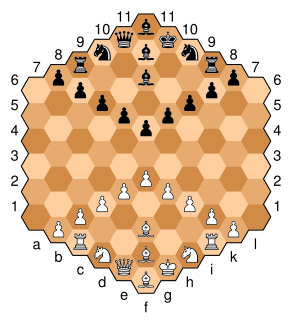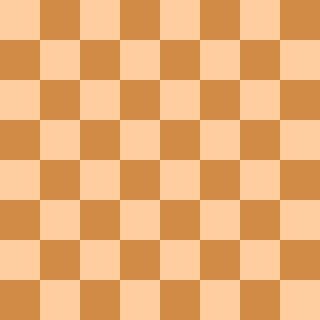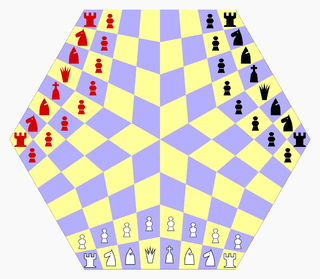Related Research Articles

A chess piece, or chessman, is any of the six different types of movable objects used on a chessboard to play the game of chess.

The knight (♘,♞) is a piece in the game of chess and is represented by a horse's head and neck. Each player starts with two knights, which are located between the rooks and bishops.
A fairy chess piece, variant chess piece, unorthodox chess piece, or heterodox chess piece is a chess piece not used in conventional chess but incorporated into certain chess variants and some chess problems. Fairy pieces vary in the way they move. Because of the distributed and uncoordinated nature of unorthodox chess development, the same piece can have different names, and different pieces the same name in various contexts. Almost all are usually symbolised as inverted or rotated icons of the standard pieces in diagrams, and the meanings of these "wildcards" must be defined in each context separately. Pieces invented for use in chess variants rather than problems sometimes instead have special icons designed for them, but with some exceptions, many of these are not used beyond the individual games they were invented for.
Makrukpronounced [màːk rúk]), or Thai chess, is a board game that is descended from the 6th-century Indian game of chaturanga or a close relative thereof, and is therefore related to chess. It is classified as a chess variant. The word "ruk" in Thai is thought to derive from "rukh" which means "chariot" in the Persian language. The Persian traders came to the Ayutthaya kingdom around the 14th century to spread their culture and to trade with the Thai kingdom. It is therefore possible that the Siamese Makruk, in its present form, was directly derived from the Persian game of Shatranj via the cultural exchange between the two people in this period. This is because the movement of Makruk Thai's queen, or the "seed", is essentially the same as the ferz in Shatranj.

Cylinder chess is a chess variant with an unusual board. The game is played as if the board were a cylinder, with the left side of the board joined to the right side. According to Bill Wall, in 947 in a history of chess in India and Persia, the Arabic historian Ali al-Masudi described six different variants of chess, including astrological chess, circular chess and cylinder chess.

Hexagonal chess refers to a group of chess variants played on boards composed of hexagon cells. The best known is Gliński's variant, played on a symmetric 91-cell hexagonal board.
Chess with different armies is a chess variant invented by Ralph Betza in 1979. Two sides use different sets of fairy pieces. There are several armies of equal strength to choose from, including the standard FIDE army. In all armies, kings and pawns are the same as in FIDE chess, but the four other pieces are different.

Minichess is a family of chess variants played with regular chess pieces and standard rules, but on a smaller board. The motivation for these variants is to make the game simpler and shorter than the standard chess. The first chess-like game implemented on a computer was a 6×6 chess variant Los Alamos chess. The low memory capacity of the early days computer required reduced board size and smaller number of pieces to make the game implementable on a computer.
Omega Chess is a commercial chess variant designed by Daniel MacDonald. The game is played on a 10×10 board with four extra squares, each added diagonally adjacent to the corner squares. The game is laid out like standard chess with the addition of a champion in each corner of the 10×10 board and a wizard in each new added corner square.
Courier Chess is a chess variant that dates from the 12th century and was popular for at least 600 years. It was a part of the slow evolution towards modern chess from Medieval Chess.

The following outline is provided as an overview of and topical guide to chess:

Rhombic chess is a chess variant for two players created by Tony Paletta in 1980. The gameboard has an overall hexagonal shape and comprises 72 rhombi in three alternating colors. Each player commands a full set of standard chess pieces.

Triangular chess is a chess variant for two players invented by George R. Dekle Sr. in 1986. The game is played on a hexagon-shaped gameboard comprising 96 triangular cells. Each player commands a full set of chess pieces in addition to three extra pawns and a unicorn.

EuroShogi is a shogi variant invented by Vladimír Pribylinec starting in 2000. The game developed from an early version of chess variant Echos in 1977, leading to Cubic Chess, then later to Cubic Shogi, and finally to EuroShogi. Instead of the classic figures, 18 black and 18 black cubes are used, which are on two opposing sides without symbols. The other two cubes on the opposite sides have one white and one black symbol. The other opposing sides are the same symbols of the opposite color - their promotion is indicated by a circle around symbol. Symbol on top of its mobility. The pieces are placed on the board so that they are oriented towards players without any symbolic surfaces. Plays on a board with 8x8 fields of the same color.

Chesquerque is a chess variant invented by George R. Dekle Sr. in 1986. The game is played on a board equaling four Alquerque boards combined, and like Alquerque, pieces move along marked lines (9×9) to the points of intersection. All the standard chess pieces are present, plus one additional pawn and one archbishop fairy piece per side. The pieces move in ways specially adapted to the Alquerque-gridded board.

Three-man chess is a chess variant for three players invented by George R. Dekle Sr. in 1984. The game is played on a hexagonal board comprising 96 quadrilateral cells. Each player controls a standard army of chess pieces.

Quatrochess is a chess variant for four players invented by George R. Dekle Sr. in 1986. The board comprises 14×14 squares minus the four central squares. Each player controls a standard set of sixteen chess pieces, and additionally nine fairy pieces. The game can be played in partnership or all-versus-all.

Rollerball is a chess variant invented by Jean-Louis Cazaux in 1998. The game was inspired by the 1975 science-fiction movie Rollerball, specifically the futuristic and violent sport portrayed in the film.

Diplomat chess is a chess variant invented by Carlos Martín-Fuertes in 2003 as a contribution to a Contest to design a chess variant on 43 squares, organised by The Chess Variant Pages. It is played on a circular board with 43 cells, including the center circle which is considered orthogonal and diagonal to every adjacent cell. The game includes a fairy piece called 'diplomat' which instead of capturing can suborn enemy pieces.
References
- ↑ Pritchard, D. B. (2007). The Classified Encyclopedia of Chess Variants (PDF). England: John Beasley. pp. 223–224. ISBN 978-0-9555168-0-1.
- ↑ Castelli, Alessandro. "Spherical chess". The Chess Variant Pages . Retrieved 6 January 2020.
- ↑ Murali, Alavoor Venkatavaradhan (2011). Chess Variants and Games. Mumbai, India: Leadstart Publishing Pvt Ltd. ISBN 978-93-81115-74-9.
- ↑ USapplication 20030020236A1,Jared Mathew Tuveson&Lukas Amadeo Saul,"Spherical Chess Board",published 30 January 2003